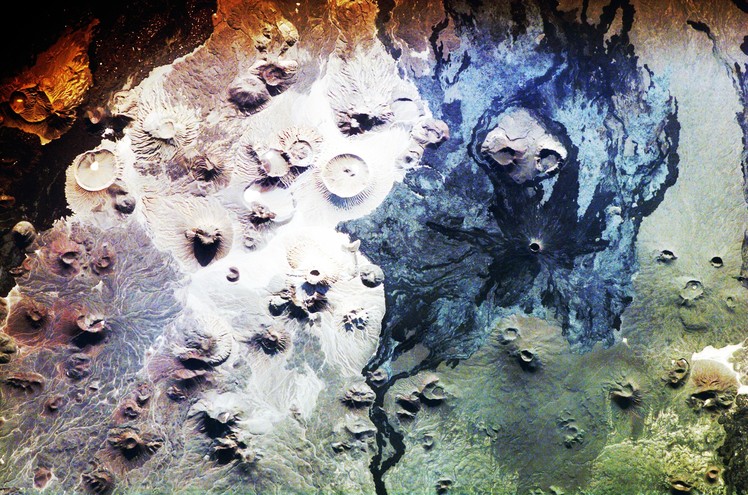
|
| Harrat Khaybar Volcanic Field, SA |
By now you know that the mountain that feeds Nazeem's hidden oasis is a volcano. Saudi Arabia actually has quite a few volcanoes-- over 2000, in fact.
The Harrat Khaybar volcanic field is particularly striking because the area is so dry. Between the lack of vegetation and the lack of water to erode the cones, the whole landscape has a desolate, lunar quality.
If you do an image search for Harrat Khaybar, you'll see many of the things that inspired Nazeem's local geography, including the pahoehoe lava he compares to the hide of an enormous elephant, a lava tube complex, and the mysterious ruins of an ancient society.
According to Wikipedia:
The basaltic lava fields of Harrat Khaybar were formed by a series of eruptions over the course of 5 million years. ... The fields cover an area of approximately 12,000 km. The most recent volcanic eruption took place between 600 and 700 AD. ...
Evidence of early human habitation has been found in the lava fields of Harrat Khaybar. The remains of Neolithic human communities have been studied there, including habitations, fences, and funerary structures built out of volcanic stones. ... Similar Neolithic structures have been studied throughout Arabia, Syria, and Jordan, and are collectively referred to as "The Works of the Old Men". ...
Researchers have studied hundreds of large stone structures nicknamed "desert kites" and "gates", but their exact purpose and function is still unknown. The gates of Harrat Khaybar are so named because they resemble horizontally laid barred gates. This type of structure is rarely attested to outside of Harrat Khaybar. The largest of the gates measure over 304 metres (1,000 ft) in length and 75 metres (250 ft) in width. ... It has been theorized that desert kites may have been used to trap and hunt wild animals. ...
According to Kennedy, the structures in the Harrat Khaybar were created between 2,000 and 9,000 years earlier than those in Jordan. As of 2017, the team of researchers had reportedly discovered more than 900 kites in Harrat Khaybar.
The volcano's eruption in this chapter was inspired by Pliny the Younger's account of the explosion of MT. Vesuvius.
"At about one in the afternoon, my mother pointed out a cloud with an odd size and appearance that had just formed. ... The cloud could best be described as more like an umbrella pine than any other tree, because it rose high up in a kind of trunk and then divided into branches. I imagine that this was because it was thrust up by the initial blast until its power weakened and it was left unsupported and spread out sideways under its own weight. Sometimes it looked light coloured, sometimes it looked mottled and dirty with the earth and ash it had carried up. ...
The ash already falling became hotter and thicker as the ships approached the coast and it was soon superseded by pumice and blackened burnt stones shattered by the fire. ...
We had earth tremors for several days, which were not especially alarming, because they happen so often in Campania. But that night they were so violent that everything felt as if it were being shaken and turned over. ... Then we saw the sea sucked back, apparently by an earthquake, and many sea creatures were left stranded on the dry sand. From the other direction over the land, a dreadful black cloud was torn by gushing flames and great tounges of fire like much-magnified lightning. The cloud sank down soon afterwards and covered the sea, hiding Capri and Capo Misenum from sight. ...
Ash was already falling by now, but not very thickly. Then I turned around and saw a thick black cloud advancing over the land behind us like a flood. ... We had hardly sat down to rest when the darkness spread over us. But is was not the darkness of a moonless or cloudy night, but it was just as if the lamps had been put out in a completely closed room. ... ash began to fall again, this time in heavier showers. We had to get up from times to time to shake it off, or we would have been crushed and buried under its weight. ...
After a while, the darkness paled into smoke or cloud, and the real daylight returned, but the Sun shone as wanly as during an eclipse. We were amazed by what we saw, because everything had changed and was buried deep in ash like snow."
The goggles that Nazeem steals in this chapter are a real thing. They're called cinder goggles or desert goggles. Here is an article about the goggles issued to British troops in Sudan in the 1880s, with some excellent pictures.
19th century steam locomotives were dirty and, quite frankly, dangerous. They burned coal (or wood, or other materials), which produced quite a lot of cinders and ashes. The firemen whose job it was to keep the train going needed something to protect their eyes. The passengers needed goggles, too, because early train cars did not have glass windows--and sometimes they didn't even have roofs.
These cinder goggles came in a variety of styles, but the basic point of all of them was to protect your eyes. Most had blue or otherwise tinted glass, because blue glass was stronger than regular 1800s glass, and so less likely to shatter upon impact with a flying chunk of burning crud. (There's not much point in wearing glasses that blind you.)
"Desert goggles" are the same idea, but issued to troops in order to protect their eyes from desert conditions instead of train debris. The British used such goggles in Sudan and the Ottomans had outfitted their troops with them by WWI. I so wanted Nazeem to have a pair of these goggles.
There is a theme song for today's chapter, Gary Numan's Ghost Nation:
Comments
Post a Comment